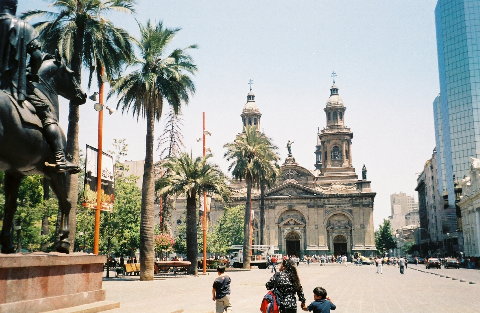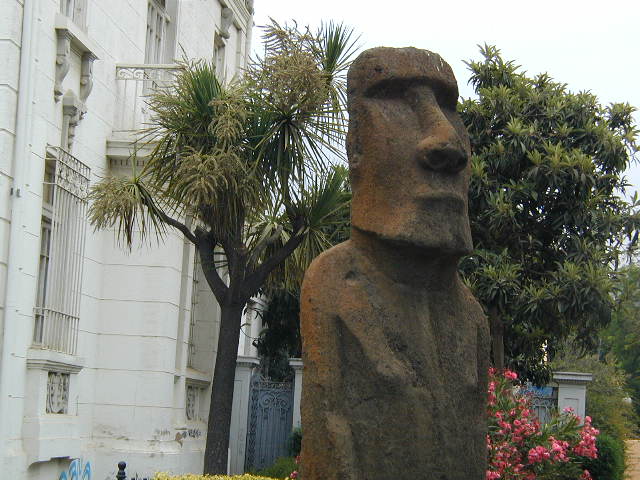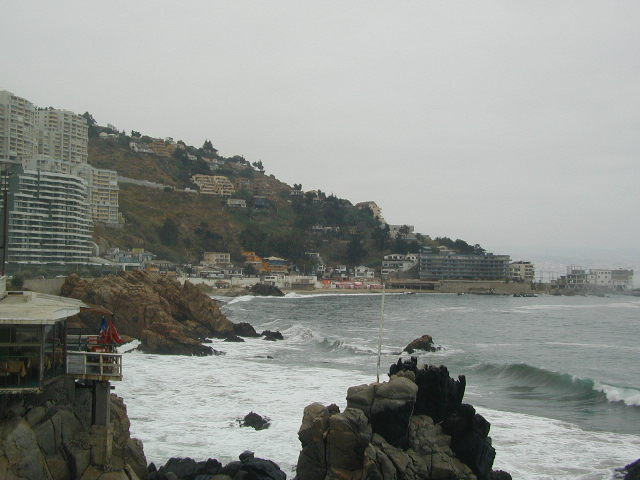
The trip to Santiago was a fairly tedious one. The check-in line for American Airlines at Washington National took nearly 40 minutes. The hop to Miami was completely full, since they had canceled an earlier flight. To compensate for the crowds, they decided to board by rows - and call exactly one row at a time. I'm not convinced that made things any faster. During that leg, I realized I had forgotten to pack my travel alarm clock. At most airports one would be able to buy one, but, unfortunately, there are pretty much no stores within the secured area in Miami, so replacing it would have to wait.
The flight from Miami to Santiago was similarly crowded. It's been a long time since I took a flight of this length (8 1/2 hours) in coach and it was definitely uncomfortable. I did manage to doze a little, but didn't get any real sleep. By the way, the Chilean man sitting next to me told me that Isla de Pascua is a bad place, but he approved of Chiloe.
On arrival, the first thing I had to do was to pay the "reciprocity tax." The governments of the U.S., Australia, Canada and Mexico charge Chileans for visas, so the Chilean government imposes a similar fee on their nationals. In the case of Americans, it's a hundred dollars, good for the life of one's passport. While I heard some people grumble about this, it seems perfectly fair to me.
The remaining formalities were straightforward. I saw a booth to purchase tickets for Transvip (a door to door shuttle service). At 8 U.S. dollars (or 4500 Chilean pesos) to Providencia, that seemed like a good option for getting to my hotel. It is cheaper to take a bus and then the metro, but that's awkward with luggage. I'll mention now that the exchange rates are about 530 CLP = 1 USD. However, I found it easier to just think of 500 pesos as being about a dollar. When you get bills from an ATM, you typically get 10,000 peso notes, which is more or less equivalent to the 20 dollar bills we're used to getting.
It was too early to check in to the Hotel Orly, so I left my bags and got directions from the desk clerk on places to go. My approach to recovering from a long flight is to keep myself moving and Santiago proved to be well suited to that. First, though, I needed to find a travel alarm clock. I knew "clock" was "reloj" in Spanish, but I admit I had to consult my phrase book to find out that alarm is "despertador." Not entirely trusting my limited vocabulary, I wrote the phrase "reloj despertador" on a piece of paper to show to store clerks. I needn't have gone to quite so much effort, as I found a store with a wide display of watches, clocks, and travel alarm clocks just a few blocks down Avenida Providencia and pointing is reasonably effective as universal language.
I continued walking towards the city center. It was quite hot out, but Santiago has a lot of green space and there was a reasonable amount of shade most of the way. I wandered through Barrio Bellavista and then back across the river to downtown. I contemplated a visit to the Palacio de Bellas Artes, but decided just to admire the view from the outside. The city center is busy with shops arranged in covered arcades, but one eventually reaches the Plaza de Armas. This is pretty much your standard Spanish colonial plaza, complete with church at one end.

The town hall, post office and other grand buildings also line the square. There are park benches and fountains and street artists and all the other odds and ends that make these plazas into effective public spaces. Further meandering brought me to the University and from there I took the metro back to Providencia and settled into my hotel room. After resting for a while, I ventured out again to have dinner. I also arranged to take a tour to the coastal cities of Vina del Mar and Valparaiso the next day.
Large bus tours are something I'd avoid for extended periods, but they can be an efficient way to handle a day excursion. The drive to the coast took about an hour and a half, passing through agricultural scenery, including the Casablanca Valley wine region. On arrival at Vina del Mar, our guide talked about the history of the city. In short, a man named Alvares bought all the land and left it to his only daughter, who married into the Vergara family. So pretty much everything is named Alvares, Vergara, or both. We went first to the Palacio Quinta Vergara, which was the home of the family. The house is a museum, which we didn't enter. Instead, we walked around the gardens and looked at the amphitheatre where a major international music festival would be held later in the month.
Our next stop was the Museo de Arqueologico e Historia Francisco Fonck. On the way there, we passed the municipal theatre, where I noticed that one of the upcoming attractions was the Alexandria Kleztet, a klezmer band from northern Virginia! Anyway, the Fonck Museum has a moai from Easter Island in front. The legend is that if you touch it, you will change sex. I may not be superstitious, but I didn't test this.

Museum admission was not included in the tour, but I was interested enough to pay the CLP 1500. Their section on Easter Island was worth the price. I was also interested in the Mapuche artefacts (lots of massive silver ornaments) and Peruvian ceramics. By the way, the museum shop has some very nice lapis lazuli pieces, though it was too early in the trip for me to be seriously tempted to shop.
We continued on through downtown Vina del Mar, which looks more or less like Miami. A few people got out to walk on the beach, while the rest of us continued up the coast a bit to Renaca. This is just another resort area, with another scenic beach. We did get the additional treat of a few sea lions coming out to play in front of us.

We then turned south towards Valparaiso. Along the way, we passed a famous floral clock. I noticed that they don't reset it for daylight savings time, so it was an hour off. Vina del Mar and Valparaiso are more or less one contiguous city, but the latter definitely feels a bit grubbier. We stopped for a pricy but good lunch at a restaurant called Bote Salvavides. Back on the bus, we drove around the hills of Valparaiso. There are a lot of brightly painted houses and several "ascensores," which are funicular railroads. Think of Angel's Flight in downtown Los Angeles or the inclines in Pittsburgh, though these are gaudier. I thought we would ride one, but we just viewed them from the bus.
Our final stop was La Sebastiana, one of Pablo Neruda's houses. The famous poet had three houses - one for each of his wives. Admission was not included and I decided that I preferred wandering the outside terrace and some crafts shops. I noticed that several of the houses on the street had quotes painted on tiles attached to them. Oddly, the quotes were by Lorca, not Neruda.
The ride back to Santiago felt like a bit of a slog and I admit to dozing during it. We got back at about six in the evening. Overall, I'd say the excursion, run by TurisTur, was reasonable value and an efficient way to do a day's sightseeing. After dinner and an early night, I was ready for more exciting sightseeing to come. But that's another chapter.
[ Back to Index | On to Next Chapter ]
last updated 23 February 2007